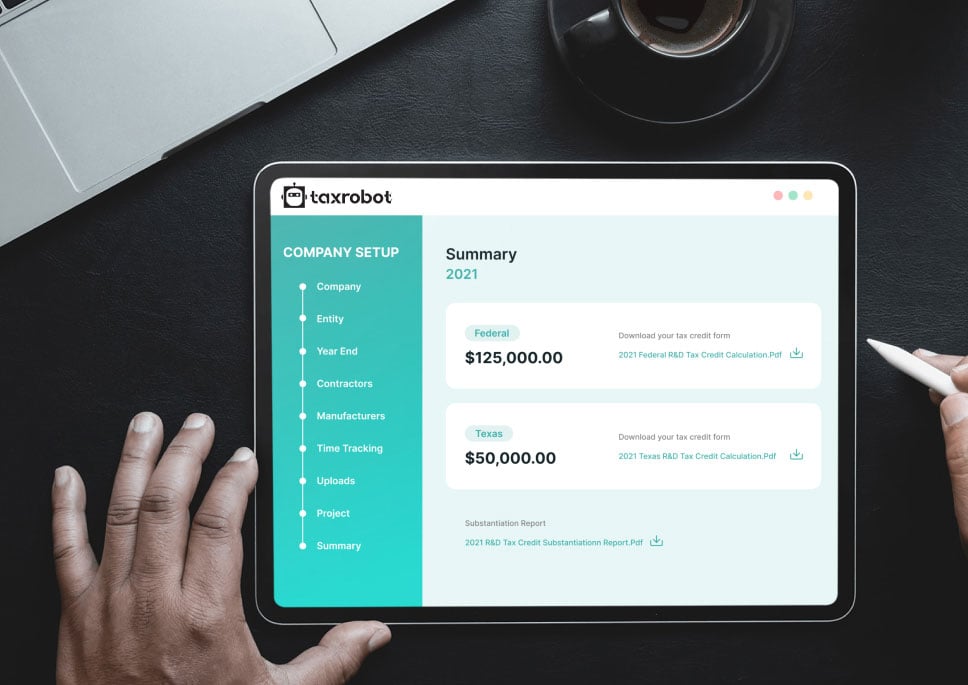Nebraska R&D Tax Credit
With TaxRobot, Nebraska R&D Tax Credit becomes more than a benefit—it becomes a catalyst for your business growth. Unleashing the incredible, simplifying the complex. This is not just tax planning; it’s financial evolution.
Maximize your State Credits today!
Put the R&D tax credit process on autopilot.
Trusted By:








Nebraska R&D Tax Credit
Discover your eligibility for Nebraska R&D tax credits and supercharge your enterprise.
Simplify and Maximize Your R&D Tax Credits in Nebraska with TaxRobot
At Tax Robot, we understand the importance of claiming R&D tax credits for businesses like yours. That’s why we’ve developed an AI-powered R&D Tax Software that takes the hassle out of the process.
With TaxRobot, you can efficiently calculate your tax credits, ensuring a maximum refund without headaches. Our team of experts, backed by years of tax consulting experience, has delivered millions of dollars in credits to clients nationwide.
Let us help you unlock the full potential of your R&D tax credits in Nebraska.
Nebraska R&D Tax Credit Details
In Nebraska, the Research and Development (R&D) Tax Credit offers a valuable opportunity for businesses to offset their R&D expenditures. Under the Nebraska Advantage Research and Development Act, taxpayers can claim a credit equivalent to 15% of the total Federal credit allowed under IRC § 41.
If your company operates in multiple states, the credit can be apportioned based on the activities conducted in Nebraska. Whether you’re a C-Corporation, S-Corporation, LLC, or Partnership, you can claim this credit. The deadline for tax filing is aligned with the Nebraska Tax Return.
To compute the credit, you must provide data such as the Federal Form 6765 and the Federal R&D Credit Amount. The credit amount can be carried forward for up to 20 years, giving you flexibility in utilizing your tax benefits.
Additionally, the credit amount varies depending on the location of your R&D activities. For off-campus sites, the credit is 15%, while on-campus sites can qualify for a higher credit of 35%. Providing the address of each college or university campus/facility where research takes place is essential.
It’s worth noting that all businesses claiming the Nebraska R&D tax credit must electronically verify the work eligibility status of newly-hired employees in Nebraska during the tax year.
How TaxRobot Works
Discover how TaxRobot revolutionizes the R&D tax credit process with its seamless operation. Our software simplifies the entire journey into three easy steps.
- You provide the necessary information for accurate calculations.
- You link your systems effortlessly, allowing TaxRobot to integrate with your existing processes seamlessly.
- Sit back and receive your refund hassle-free.
With TaxRobot’s user-friendly platform, you can focus on running your business while we handle the complexities of R&D tax credits. Our algorithms save you valuable time, ensuring a smooth and efficient experience.
Value-Based Pricing and Audit Support
At TaxRobot, we prioritize your satisfaction and success. That’s why we offer value-based pricing, ensuring transparency and fairness in our fees. You only pay when you receive a tax credit, eliminating any upfront financial burden.
We stand by our software’s accuracy and compliance, providing audit support to address any inquiries or requests that may arise. With TaxRobot, you can confidently navigate the R&D tax credit process, knowing that we have your back.
Experience our commitment to your financial well-being, and let us guide you through every step of the way.
Time-Saving Automation and Documentation
TaxRobot values your time and aims to streamline the R&D tax credit process. Our software utilizes advanced algorithms that save you precious hours, allowing you to focus on running your business.
With TaxRobot, you can trust our system to generate accurate reports and documentation that satisfy statutory and IRS requirements. Experience the efficiency of our time-saving automation and enjoy the peace of mind that comes with superior documentation.
Let TaxRobot handle the details, so you can focus on what truly matters – growing your business.
Maximize Your R&D Tax Credits in Nebraska with TaxRobot
TaxRobot is your trusted partner in simplifying and maximizing your R&D tax credits in Nebraska. We ensure a seamless and efficient process with our AI-powered R&D Tax Software, backed by our expertise and value-based pricing.
Experience bigger refunds, superior documentation, and audit support, all while saving time with our time-saving automation. Take advantage of the valuable tax benefits available to your business.
Take a sneak peak

- Limited Time Offer
- Simple Onboarding
- Easy to Use
R&D Tax Credits FAQs
The four-part test as outlined in the Internal Revenue Code is used to determine qualified R&D activity.
The Four-Part Test
1). New Or Improved Business Component
Creation of a new product, process, formula, invention, software, or technique; or improving the performance, functionality, quality, or reliability of existing business component.
- Construction of new buildings or renovation of existing buildings
- Invention of a software application
- Manufacturing of a new product or the improvement of the production process for an existing product
- Creation of design documentation
2). Technological In Nature
The activity fundamentally relies on principles of the physical or biological sciences, engineering, or computer science. A taxpayer does not need to obtain information that exceeds, expands or refines the common knowledge of skilled professionals in a particular field.
- Physics (relationship between mass, density and volume; loading as the
result of gravitational attraction) - Engineering (mechanical, electrical, civil, chemical)
- Computer science (theory of computation and design of computational systems)
3). Elimination Of Uncertainty
Uncertainty exists if the information available to the taxpayer does not establish the capability or method for developing or improving the business component, or the appropriate design of the business component.
- The capability of a manufacturer to create a part within the specified tolerances
- The appropriate method of overcoming unsuitable soil conditions during construction
- The appropriate software design to meet quality and volatility requirements
4). Process Of Experimentation
A process designed to evaluate one or more alternatives to achieve a result where the capability or method of achieving that result, or the appropriate design of that result, is uncertain as of the beginning of the taxpayer’s research activities.
- Systematic process of trial and error
- Evaluating alternative means and methods
- Computer modeling or simulation Prototyping Testing
The R&D tax credit is one of the most misunderstood tax incentives available. Considering the myriad of industries and activities that legally qualify for the credit, the term “research and development” is a misnomer. Additionally, the R&D tax credit requires specialized knowledge and technology to identify and calculate the incentive properly.
Companies of various industries are unaware that they are eligible to claim the R&D tax credit. Under the Internal Revenue Code’s definition of R&D, many common activities qualify. You can get tax benefits for industries including software, technology, architecture, engineering, construction, manufacturing, and more.
The R&D tax credit can be claimed for all open tax years. Generally, open tax years include the prior three tax years due to the statute of limitations period. In certain circumstances, the law allows businesses to claim the R&D tax credit for an extended period of time. It is common for companies to amend previous tax years to claim this benefit and reduce the maximum amount of tax liability.
Partnerships and S corporations must file this form to claim the credit. The credit will flow from the Form 6765, to the Schedule K-1, to the Form 3800 on the individual’s tax return. For individuals receiving this credit that have ownership interest in a partnership or S corporation, Form 6765 is not required on the individual return.
Individuals claiming this credit can report the credit directly on Form 3800, General Business Credit if their only source for the credit is a partnership, S corporation, estate, or trust. Otherwise, Form 6765 must be filed with the individual’s tax return (e.g. sole proprietorship).
For tax years prior to 2016, the credit can be used to reduce the taxpayer’s regular tax liability down to the tentative minimum tax. The credit cannot be used to offset alternative minimum tax. Beginning in tax year 2016, eligible small businesses have expanded utilization for the credit. For these eligible small businesses, the regular tax liability can offset alternative minimum tax using the “25/25” rule.
What our customers have to say
I highly recommend TaxRobot to anyone considering an R&D Tax Credit software to complete their analysis.

We decided to switch to TaxRobot… Best decision we’ve ever made. More affordable, and less complicated.

I couldn’t believe how easy it was! In under an hour, we saved enough money to hire a new employee.
